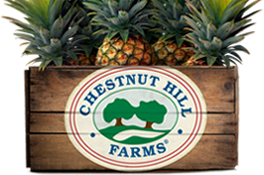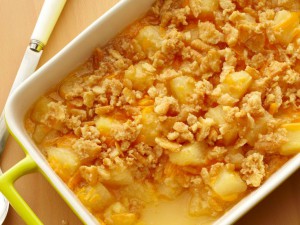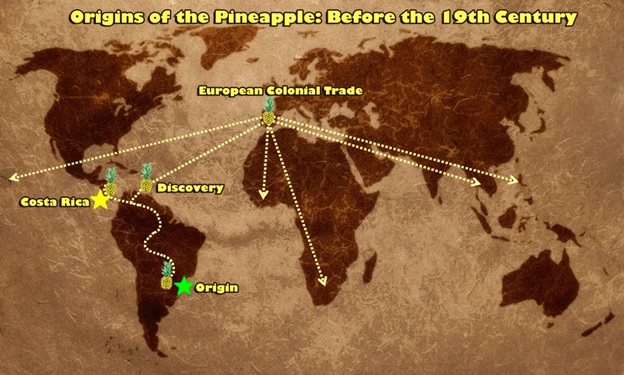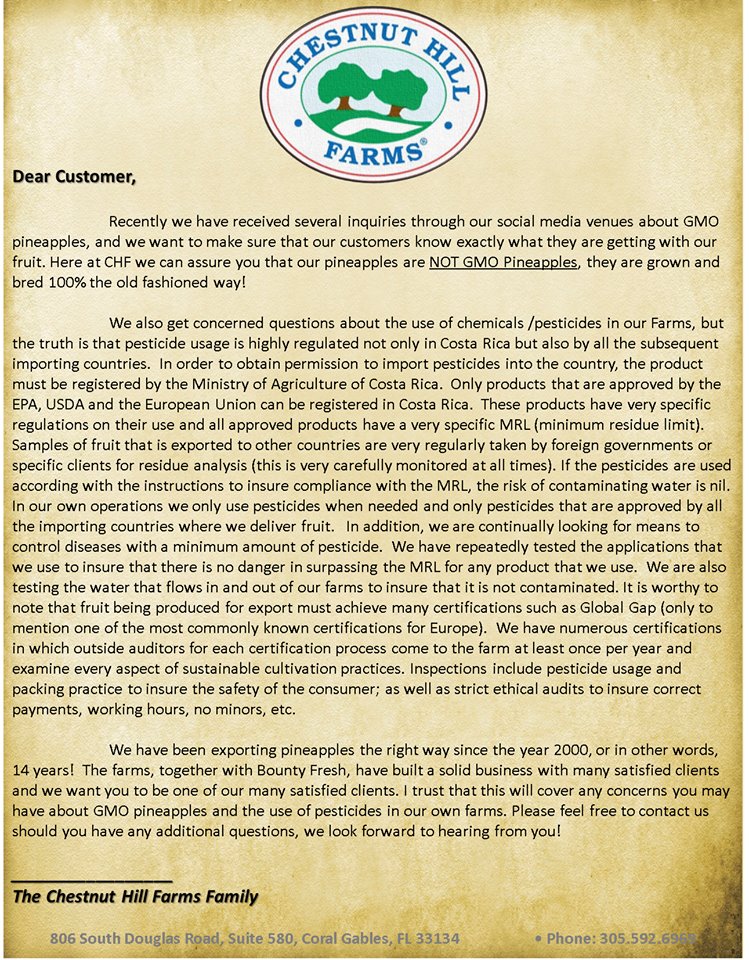-
Featured Posts
- St. Patrick’s Day Pineapple Punch
- Sheet Pan Perfect Pineapple Ham
- Can A Pineapple Really Live Under the Sea?
- Say Aloha to Our Hawaiian-style Ham and Pineapple Pasta Recipe
- Holiday Joy, Hanukkah, and Pineapple Kugel
- What are China’s Pineapple Science Awards?
- Fuel Up with Paleo Pineapple Fried Rice
- Best Gluten-Free Pineapple Upside Down Cake
- Piña Colada Pie in a Jar
- Slow Cooking Your Pineapple This Fall
Featured
Fresh Pineapples and the Antioxidants
By Dr. Lloyd Berg, PhD.
As a mission of our on-going blog series, our goal is to educate consumers about the health benefits of fresh pineapples. The third installment in this series, today we focus on the importance of antioxidants and pineapples as an excellent antioxidant source!
Fresh pineapples contain vitamins A and C, flavonoids and manganese – all important antioxidants. But what exactly are antioxidants and why should thinking about them be a part of our produce purchasing process?
Without proposing a college-level lecture, the most basic explanation we can give goes a little something like this: Our body is made up of billions of cells and each cell can be trillions of molecules. Our cells are what make up the organs and systems our body requires to operate in a healthy way. So the best way to keep our organs functioning and healthy is to take care of them at a cellular level.
Think of antioxidants this way: a cell’s molecules can be harmed at any time for a variety of reasons. The harm comes in a form called “free radical.” Antioxidants protect the body from damage created by these free radicals. In fact, cells can be so badly damaged that they could eventually die off – of course, never to be replaced. This kind of stress to your body’s cells seems to play a significant role in many diseases, including cancers. In essence, if we add antioxidants to our diets we have a natural defense system against some of the most serious health risks.
Pineapples are a price source for antioxidants. They are nearly at the top of the list of manganese and Vitamin C sources – all needed to serve many important functions in the body. In addition to serving as antioxidants, these vitamins and minerals similarly build and repair bodily tissue, help with bones development and promote wound healing.
So if you want a natural way to enhance your body’s healing mechanisms, promote overall good health and tantalize your taste buds, fresh pineapples are the way to go. Just dice them up and help defend your health one bite at a time!
This blog entry is part of a multi-post series on the potential benefits of pineapples. For more information about pineapple consumption, please contact us at info@chfusa.com.
Posted in Featured, Tips & Tall Tales
Tagged health
Give Thanks for Sweet Side Dishes!
By Dr. Lloyd Berg, PhD.
Turkeys might take center stage at the dining room table this Thanksgiving, but everyone knows filling side dishes are really the fan favorites!
And while traditional green bean casseroles are standard fare, it’s time they move over and let something a little bit more sweet have a go at impressing the family.
This month’s recipe comes from various sources across the web. Meet the quick and simply named “Pineapple Casserole.” Made with either fresh or canned pineapple chunks, we’re sure this will be at hit at your holiday affair!
Ingredients:
Makes 4 to 6 servings
- 20 oz. fresh pineapple, crushed, with juice
- 1/2 cup white sugar
- 2 teaspoons all-purpose flour
- 1 pinch salt
- 3 eggs, beaten
- 3 slices white bread, cut into cubes
- 6 tablespoons butter
Directions
- Preheat oven to 350 degrees F (175 degrees C). Grease a 1 quart baking dish.
- In a small bowl, mix together the sugar, flour and salt.
- Add eggs, pineapple and juice. Mix well.
- Pour into baking dish, top with bread cubes and dot with butter. Bake for 45 minutes or until top is golden brown.
To style, top with fresh pineapple rounds.
Enjoy,
Dr. Lloyd
For more information about Chestnut Hill Farms its products, please contact our offices at (305) 592-6969.
Tall Tales: A Brief History of Pineapple Exports
By Dr. Lloyd Berg, PhD.
In the United States, the average consumer believes that most of the world’s pineapples come from Hawaii – and even furthermore, that they are a native fruit of The Aloha State. And although long has Hawaiian tourism and state marketing encouraged the connection, this belief couldn’t be anymore false.
Today, the leading producer of pineapples is Costa Rica – home to Chestnut Hill Farms’ Perfect Pineapple™. The infographic below shows how the pineapple arrived to our little piece of paradise:
- Pineapples are believed to be native to Paraguay and the southern part of Brazil.
- Natives of that region spread the fruit throughout South and Central America, and all the way through the Caribbean region, including the West Indies.
- It was on the island of Guadeloupe in 1493 that Christopher Columbus came upon the fruit and took with him back to Europe.
- After more than 150 years of consumption by only the most elite, European powers began harvesting the fruit in respective colonies. The colonial pineapple trade in the late 1600s and early 1700s solidified the pineapple as a status symbol.
- Even with all of this migration, it still took more than 300 years after Columbus’ discovery for the pineapple to finally make its way to Hawaii. The first appearance of the fruit wasn’t until 1813.
- Pineapples have been growing in Costa Rica for what is believed to be more than 400 years.
- Chestnut Hill Farms began growing pineapples in 2000.
For more information about Chestnut Hill Farms’ Perfect Pineapple™ please contact our offices at (305) 592-6969.
Posted in Featured, Tips & Tall Tales
Be Proactive in Fighting the Flu: Natural Foods Can Help
By Dr. Lloyd Berg, PhD.
While the beginning of November is just a few weeks away from “the most wonderful time of the year,” it also marks the beginning of a rather less favorable period – flu season.
With flu activity most commonly peaking between December and February, most Americans take extra precautions in making sure the festive holidays are met without any setbacks. Being proactive about your health and taking preventative measures is probably the best way to fight the common cold. And by taking a natural approach, using fresh pineapple juice might just be your best defense!
Pineapples contain bromelain, an enzyme with anti-inflammatory properties. It fights infections and kills bacteria. Pineapples are also abundant in vitamin C, which we all know is the secret ingredient in any over the counter immunity boosters.
In fact, it’s been documented by holistic wellness practitioners that the juice from fresh pineapples can suppress coughs five times more effectively than cough syrup. With one cup of pineapple juice containing nearly 50% of the daily requirement for vitamin C intake, drinking a glass of fresh pineapple juice can help soothe a sore throat and aid the body to expel any oncoming mucous easily.
This flu season, make sure to prepare by keeping your immunity up and your kitchen stocked. Natural approaches to drugstore medicine are not only better for your overall health, but can be cheaper. So next time you’re in the produce aisle, remind yourself to pick up some ingredients for dinner, as well as a few back-ups for medicine cabinet.
This blog entry is part of a multi-post series on the potential benefits of pineapples. For more information about pineapple consumption, please contact us at info@chfusa.com.
Posted in Featured, Tips & Tall Tales
Tagged health
Benefits of Pineapples: A Bromelain Brain Boost
By Dr. Lloyd Berg, PhD.
“How is pineapple good for you again?” If you find yourself asking this question, it might be time to visit the produce aisle.
As part of a multi-part blog series, we’d like to educate our customers on how consuming “The Perfect Pineapple®” can bear fruit to improvements in overall well-being. And while pineapples have a plethora of health benefits, our inaugural blog post’s focus (super-charged, we might add) is on how just a few bites a day can potentially improve brain health.
Studies have found that consuming pineapple can improve your memory. Along with Vitamin B1 and manganese naturally found within the fruit, research shows the enzyme “bromelain” can play a key role in promoting cognitive functions.
The core of the findings is found – well, actually, at the core of the crop. The center core of a pineapple fruit is an extension of the stalk where the bromelain is concentrated. Bromelain is known to stimulate blood flow to the brain and make one more alert. So much so that pineapples has often been cited as the fruit of choice by musicians, singers and actors, because of the need to memorize sheet music, lyrics and script lines.
Yet, some may forget (we’ll take our chances and bet on those not consuming enough pineapple) that bromelain has been used for hundreds of years in folk medicine as a treatment to various health problems since its discovery on the island of Guadeloupe in 1493 by Christopher Columbus.
Needless to say, with its potent mix of vitamins, antioxidants, and enzymes—in particular, bromelain—pineapple is an all-body anti-inflammation cocktail; one that – hopefully – you’ll remember to add to your grocery list tonight.
This blog entry is part of a multi-post series on the potential benefits of pineapples. For more information about pineapple consumption, please contact us at info@chfusa.com
Posted in Featured, Tips & Tall Tales
Tagged health
FRUKTUS Foundation Promotes 29 New Community Leaders
By Raul Romero, President and COO
The FRUKTUS Foundation, a private non-profit organization dedicated to promoting, supporting and developing sustainable communities in Costa Rica’s Caribbean region, recently awarded 29 students diplomas for their completion of the Foundation’s “Harvesting Leaders, Growing Opportunities” program this summer.
The adult educational program, designed to empower inhabitants from five of the communities within Chestnut Hill Farms pineapple and banana-producing areas, focuses on teaching workers healthy, cognitive and sustainable standards and providing them with the tools to become positive community leaders. A variety of topics such as gender issues, conflict resolution and team work are discussed, among other important work/life strategies.
Students receive their diplomas and warm congratulations from the FRUKTUS Foundation staff and partners during a graduation ceremony for the “Harvesting Leaders, Growing Opportunities” program this summer.
In addition to the recent program graduation, the FRUKTUS Foundation also helped build and inaugurate a new pre-kindergarten classroom at the Rio Cascadas School in La Lydia, benefitting more than 25 local students and children of many farm workers. Elementary and high school students in the area, and families of workers, welcomed nearly 1,000 school packages donated by FRUKTUS in its mission to improve and maintain a better quality of life for community members.
The FRUKTUS Foundation also completed the following initiatives during the first half of 2014:
- Began preliminary development of a baseball stadium for the community of El Limbo
- Planted 250 trees, along with Rainforest Adventures Costa Rica, in an effort to reforest areas located within pineapple farms
- Sponsored a summer camp excursion for more than 70 teenagers from three communities to the leading amusement park in San José.
- Hosted inspirational speaker Gaetano Pandolfo for a special lecture and book signing
- Launched a National Pineapple Magazine publication for communities in the region to maintain literacy and industry knowledge
Research was also a priority this year for the Foundation, as Earth University was invited to partner on local, scholarly discussions concerning water issues, collection and garbage disposal in five of the areas communities – and nearly 20 students from San José’s UN Peace University Master’s Program of Responsible Management & Sustainable Economic Development were invited to create a case study on how pineapple activity can be sustainable and positive for economic growth of local communities. Needless to say, the Master’s students were very impressed with region’s social vision and the Foundation’s projects.
FRUKTUS Foundation is a private nonprofit organization, whose members are second generation family members of shareholders of companies dedicated to the pineapple and banana production in Costa Rica. The farms Piñera Parismina (pineapple), Agroindustrial Bananera del Caribe (pineapple), Bananatica de Costa Rica (banana) and Chestnut Hill Farms are the main sponsors of FRUKTUS Foundation.
To join Chestnut Hill Farms and become a supporter of the FRUKTUS Foundation, please contact Andrés Corrales at andres@fruktus.org.
Posted in Featured, Latest News
One Last Summer Hurrah
By Dr. Lloyd Berg, PhD.
Summer is NOT over just yet! Officially ending September 22, we figured why not raise a glass to everyone’s favorite season and savor the final warm days of the year with a sweet and simple Pineapple Cooler.
This month’s recipe comes from Courtney Whitmore and Pizzazerie.com. Courtney’s entertaining expertise and recipes have been featured in Better Homes & Gardens, HGTV.com, Ladies Home Journal, AOL’s DIY Life, Access Hollywood, and MarthaStewart.com – so we’re sure you’ll trust on this one.
Enjoy,
Dr. Lloyd
To view the full recipe, visit here page here.
For more information about Chestnut Hill Farms its products, please contact our offices at (305) 592-6969.
September is Fruits & Veggies – More Matters® Month!
By Dr. Lloyd Berg, PhD.
September is Fruits & Veggies—More Matters® Month and our partner
Produce for Better Health Foundation (PBH) is celebrating by providing a ‘Fuel Up with Every Form’ toolkit for helping Americans increase fruit and vegetable consumption for better health. The kit provides everything from important nutritional facts for every day practice to fun and easy recipes for at-home meal planning. For starters, here’s the Top 10 Reasons to Eat More Fruits & Veggies:
10. Color & Texture
9. Convenience
8. Fiber
7. Low in Calories…
To continue reading, visit Fruits & Veggies More Matters page.
Needless to say, pineapples are among the fresh fruits that help make up a
healthy diet and lifestyle. Make sure to add a pineapple to your cart today in
celebration of this month’s fruit festivities!
Interested in fueling up with more fruits and veggies this month? Visit this
website, here.
For more information about Chestnut Hill Farms and its dedication to increasing
pineapple consumption, please contact us at info@chfusa.com.
Posted in Featured, Latest News, Recipes, Tips & Tall Tales
The Truth About Pineapple “Seeds”
Growers that cultivate pineapple often use the word “seed” for the sucker that is used for planting but this is the incorrect use of the word “seed”. Pineapples do occasionally produce true tiny black seed just below the peel of the fruit which can be found when the fruit is peeled but, in general, pineapples are highly self-incompatible (a general name for several genetic mechanisms in angiosperms, which prevent self-fertilization and thus encourage outcrossing. In plants with SI, when a pollen grain produced in a plant reaches a stigma of the same plant or another plant with a similar genotype, the process of pollen germination, pollen tube growth, ovule fertilization, and embryo development is halted at one of its stages, and consequently no seeds are produced. SI is one of the most important means to prevent selfing and promote the generation of new genotypes in plants, and it is considered as one of the causes for the spread and success of the angiosperms on the earth). Hummingbirds, when present, are the usual natural pollinators but most often when the pollen germinates on the female part of the flower known as the stigma, it usually does not grow through the style and fails to fertilize ovary. Despite this self-incompatibility the fruit will still develop because pineapples are parthenocarpic which means the fruit goes ahead and develops without fertilization of the ovary. Most fruits require fertilization for fruit development. Another example of a parthenocarpic fruit is bananas.
The tiny black seeds that can be found occasionally can be grown into a pineapple plant but it is a very slow process. I have grown them using two plastic glasses. I put soil in one glass and place the seed on top of the soil and cover them with a very thin layer of soil and then carefully moisten the soil (not to the point of saturation). I then invert the second clear plastic glass on tape it to the top of the glass with the soil to form a miniature greenhouse. After 2-3 weeks you will see very small green leaves emerging from the soil. It will take several months to obtain a plant large enough to plant into the ground or a large pot to eventually produce the fruit.
This time consuming process is the reason that commercial pineapple growers use suckers to plant in the field. In a commercial operation, after the fruit is harvested some of the axillary buds that are at the base of every leaf of the pineapple plant will begin to develop into small pineapple suckers which will be large enough to plant in the field in a couple of months. We incorrectly call these suckers “seed” they should probably really be called “daughters”.
Posted in Featured, Latest News, Tips & Tall Tales









